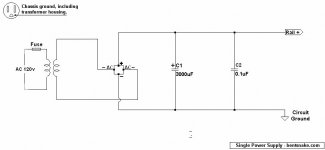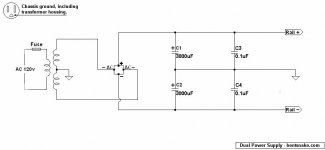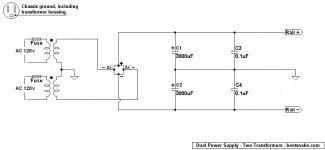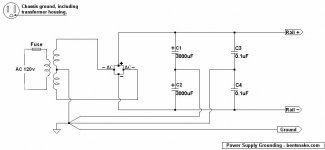The normal transformer requirement for a ClassAB amplifier is VA is approximately the total maximum output power to two times the total maximum output power.
I add an over-riding condition: The smallest toroid transformer for a power amplifier should be around 160VA to get a good balance of PSU voltage as output varies, mostly due to excessive transformer regulation for very small transformers.
eg.
two channels of 20W amplifiers gives 40W of total maximum output power.
Therefore the amplifiers will work with a toroid transformer from 40VA to 80VA
So it'll work from 40VA to 80VA, but from your overriding condition you would use 160VA, right?
.
<< I have an LM1875 kit but I haven't bought a transformer yet and I was wondering about what I need. I plan to use 8 ohm speakers and the data sheet shows that at a 20W power output that there is 20W of heat dissipation for the voltage I plan to use. A naive estimation of the power requirements would mean that I need 40W per channel or 80W total. Would a 120VA transformer be enough for this kit? >>
For some reason it seems to be unknown that watts and VA are the same thing for practical purposes. That is:
watts = volts x amps = VA
It's just a rule of thumb that power supplies should be at least 150% of the amplifier wattage output you want. 200% is better. More can't hurt, although it won't help much either.
This is simply because, as you observe, audio chips waste a lot of power in the form of heat, and this power has to come from the power supply.
In a sidebar, I personally see no advantage to using expensive toroid transformers.
.
<< I have an LM1875 kit but I haven't bought a transformer yet and I was wondering about what I need. I plan to use 8 ohm speakers and the data sheet shows that at a 20W power output that there is 20W of heat dissipation for the voltage I plan to use. A naive estimation of the power requirements would mean that I need 40W per channel or 80W total. Would a 120VA transformer be enough for this kit? >>
For some reason it seems to be unknown that watts and VA are the same thing for practical purposes. That is:
watts = volts x amps = VA
It's just a rule of thumb that power supplies should be at least 150% of the amplifier wattage output you want. 200% is better. More can't hurt, although it won't help much either.
This is simply because, as you observe, audio chips waste a lot of power in the form of heat, and this power has to come from the power supply.
In a sidebar, I personally see no advantage to using expensive toroid transformers.
.
Yes, that's what I do.
Hi,
This is also valid with any voltage ?
And this is also valid with dual mono setup ?
For ex :
psu is two toroids with two secondary 0/20 v, what VA I need ?
and, psu is one toroid with two secondary 0/20 v, what VA I need ?
Phil.
VA determines the transformer regulation.
Low VA = high regulation.
High regulation = high voltage sag when power is delivered.
That's why I recommend no less than 160VA for a power amplifier.
Using two small transformers wastes money.
Using two 160VA transformers wastes more money.
Just buy the single transformer that you decide is correct for your duty.
Is this also valid with any voltage?
Is this also valid with dual mono set up?
Must be something that is different between english grammar and other languages. The order of the words changes the meaning of the sentence.
Now:
Is "what" valid at any voltage?
and
Is "what" valid when dual mono?
What are you referring to?
Low VA = high regulation.
High regulation = high voltage sag when power is delivered.
That's why I recommend no less than 160VA for a power amplifier.
Using two small transformers wastes money.
Using two 160VA transformers wastes more money.
Just buy the single transformer that you decide is correct for your duty.
for questions these should read:This is also valid with any voltage ?
And this is also valid with dual mono setup ?
Is this also valid with any voltage?
Is this also valid with dual mono set up?
Must be something that is different between english grammar and other languages. The order of the words changes the meaning of the sentence.
Now:
Is "what" valid at any voltage?
and
Is "what" valid when dual mono?
What are you referring to?
Hi,
This is also valid with any voltage ?
And this is also valid with dual mono setup ?
For ex :
psu is two toroids with two secondary 0/20 v, what VA I need ?
and, psu is one toroid with two secondary 0/20 v, what VA I need ?
Phil.
The type or number of transformer(s) doesn't enter in. The point is to supply the op amp(s) with enough power.
Bear in mind that for all practical purposes watts and VA are the same thing. That is:
watts = volts x amps = VA
VA = volts x amps = watts
First you must specify the power output of your amplifier--which is the power output of the op amp(s). Then the transformer VA you need is 1.5 times the power output of your amplifier minimum, preferably twice the power output of your amplifier.
For a 20 watt/VA amplifier you'd use a 30VA power transformer minimum, preferably 40VA.
For a 50 watt/VA amplifier you'd use a 75VA power transformer minimum, preferably 100VA.
So when shopping you'd look only at transformers putting out a secondary voltage of your specified 20 volts. You'd then scroll down the VA column to find a number that's 1.5 times (minimum), or 2 times (preferred), the wattage/VA output of your amp.
That's assuming I understand your question, which I'm not sure I do, but I thought I'd take a shot.
.
Hi,
Thank's for the two answers..
I think my question was not clear enough, maybe english grammar !
So, it's more clear for me, for exemple if I need 160VA for one transformer, I might need 80 VA with two toroids (80x2= 160), in dual mono ps.
Whatever the voltage.
Phil.
Thank's for the two answers..
I think my question was not clear enough, maybe english grammar !
So, it's more clear for me, for exemple if I need 160VA for one transformer, I might need 80 VA with two toroids (80x2= 160), in dual mono ps.
Whatever the voltage.
Phil.
<<...for exemple if I need 160VA for one transformer, I might need 80 VA with two toroids (80x2= 160), in dual mono ps. >>
Nope, not yet.
One transformer supplying one 40-watt chip, use an 80VA transformer.
Two transformers supplying one 40-watt chip, use two 80VA transformers.
This is because both transformers have to be able to supply the same amperage, which is the case of 20 volts is 4 amps.
VA = watts = volts x amps, therefore:
amps = watts / volts = VA / volts
Consider, for example, an 80VA and 40VA transformer in series. The 40VA transformer is is wound with smaller gauge wire (the only real difference) good for carrying 2 amps, that would overheat if forced to carry 4 amps.
Maybe it's time for some illustrations. What the heck, it's always time for some illustrations.
Notice the similarity between the second and third circuits shown. The difference is that the secondary windings are in physically different locations, but electrically they still work the same way.
.
Nope, not yet.
One transformer supplying one 40-watt chip, use an 80VA transformer.
Two transformers supplying one 40-watt chip, use two 80VA transformers.
This is because both transformers have to be able to supply the same amperage, which is the case of 20 volts is 4 amps.
VA = watts = volts x amps, therefore:
amps = watts / volts = VA / volts
Consider, for example, an 80VA and 40VA transformer in series. The 40VA transformer is is wound with smaller gauge wire (the only real difference) good for carrying 2 amps, that would overheat if forced to carry 4 amps.
Maybe it's time for some illustrations. What the heck, it's always time for some illustrations.
Notice the similarity between the second and third circuits shown. The difference is that the secondary windings are in physically different locations, but electrically they still work the same way.
.
Attachments
.
An addendum. The difference between schematic (symbolic) wiring, and the way things are wired in the real world.
The below circuit is mate to the three above. The three above show schematic wiring, the circuit below shows the preferred real-world wiring.
That is...preferred by me. Perhaps not by everybody.
.
An addendum. The difference between schematic (symbolic) wiring, and the way things are wired in the real world.
The below circuit is mate to the three above. The three above show schematic wiring, the circuit below shows the preferred real-world wiring.
That is...preferred by me. Perhaps not by everybody.
.
Attachments
.
Transformers in series: voltage adds, amperage remains the same.
Transformers in parallel: amperage adds, voltage remains the same.
IMPORTANT: "Transformers in parallel" is given only for explanatory purposes. Do not wire transformers in parallel. Doing so will create random eddy currents and voltages with unpredictable results.
.
Transformers in series: voltage adds, amperage remains the same.
Transformers in parallel: amperage adds, voltage remains the same.
IMPORTANT: "Transformers in parallel" is given only for explanatory purposes. Do not wire transformers in parallel. Doing so will create random eddy currents and voltages with unpredictable results.
.
post29
The wiring is wrong.
You posted similar in other Threads and each time you are told it is wrong.
Why do you keep posting this unhelpful information?
The wiring is wrong.
You posted similar in other Threads and each time you are told it is wrong.
Why do you keep posting this unhelpful information?
watts = volts x amps = VA
VA = volts x amps = watts
Maybe just semantics, but the above should incorporate additional terms for power factor and losses within the transformer.
For a typical full- or half-wave bridge the power factor won't be 1.00, but more like 0.7. Also, transformer losses are typically higher, on a percentage basis, with smaller cores (i.e., smaller VA ratings).
In the current application being discussed, incorporation of all these factors may suggest to the original poster a VA rating approaching 160.
Regards,
Rob
Hence rules of thumb. As opposed to confusing the poor guy completely. He's not looking for an EE degree, he just wants to build a chip amp.
However, I shouldn't have flipped back and forth between 40 watts, 80 watts, and 160 watts. Rotten explanation, my bad. But you can't edit these things.
However, I shouldn't have flipped back and forth between 40 watts, 80 watts, and 160 watts. Rotten explanation, my bad. But you can't edit these things.
Last edited:
Ah, no, that's not the case when the onboard protection scheme doesn't usually work (and I've heard far too much about that one). We should not like to request breakage. The track record for durability isn't spectacular.The normal transformer requirement for a ClassAB amplifier is VA is approximately the total maximum output power to two times the total maximum output power.
Free Translation: Treat the LM1875 as if it were an unprotected, thumbnail size discrete amp, and that is when it doesn't break. Breakage occurs after eventual device corruption, which may take a few months time to accumulate enough damage to be measurable, and then there is offset.
Actually what we need is guaranteed not more than 22 watts to the speaker, but in such case, the LM1875 *system* will output 14 watts waste heat, exactly. So, the answer is a 36va transformer, that much or less is safe and doesn't break.
This will need to be monoblocs--because we'd like to expose the LM1875 to not more than this much transformer no matter if stereo or monoblock/dualmono, but we'd also like some power, and that means 1 of 36va transformer per each channel, so that we can get 22 watts per channel, reliably.
The Allied store brand 36va 1 ampere 18-0-18 (or same Hammond transformers) are suitable and we'd probably like to have a pair of those. Also, we'd like to have a couple of bridge rectifiers and something very much like 4x 2200uF caps per each channel (greater capacitance is usable if there were either some labor or a slight creativity involving a more functional series element in-between amp and power boards, resulting in larger and clearer peak power).
P.S.
If we want more power then we want a parallel amplifier. It is a difficult build (because she doesn't like to match) but the luxury tone of high linearity can be a treat on music replay.
Conversely, for the task of television movie soundtracks, we should rather be looking at LM3886 kits, with their rather sharp tone (depending on speaker, may be abrasive on music) that is so very good at intelligible vocals on movies, and with the working protection, the transformer is easier to select.
P.P.S.
If one would like to ignore the power input advisement (amperage), then simply make the LM1875 Single Rail amplifier, which involves an output cap, and then the typical breakage mode of 1 rail worth of dc offset is already existing and handily blocked by the required series cap, so the problem is null, not a risk and not in effect.
Even so a thosand va transformer is still very likely to break a poorly protected amplifier, by request. Meanwhile. . . back to appropriate transformer current!
P.P.P.S.
If the -input is overcurrent, even slightly, then the protection fails.
Also notable is the single rail schematic's reduced feedback current, which also just happens to serve to prevent breakage. http://www.ti.com/lit/ds/symlink/lm1875.pdf 200k vs 10k. . . the 10k is very very light current! This sheds some light on the breakage that occurs when same resistor is at 680R~1k on popular split rail builds (which end in questions and fried speakers), so I'd like to suggest that this resistor (feedback-shunt) has an appropriate range of 2k7~10k to keep the current light, and that its partner (the feedback resistor) has an appropriate range of 100k~200k, also for light current (although a smaller value could be used if the power voltage is smaller).
For example, this split rail build http://www.diyaudio.com/forums/atta...875-amplifier-board-lm1875_turbo-ii_color.gif has the needed specs for durability.
. . . and amplifier.Maybe just semantics, but the above should incorporate additional terms for power factor and losses within the transformer.
With the typical system efficiency at about 0.61%, the transformer VA can be multiplied by the efficiency, such as 36va*0.61=22W, which is a probably safe LM1875 chip.
Codswallop.Ah, no, that's not the case when the onboard protection scheme doesn't usually work (and I've heard far too much about that one). We should not like to request breakage. The track record for durability isn't spectacular.
Free Translation: Treat the LM1875 as if it were an unprotected, thumbnail size discrete amp, and that is when it doesn't break. Breakage occurs after eventual device corruption, which may take a few months time to accumulate enough damage to be measurable, and then there is offset.
Actually what we need is guaranteed not more than 22 watts to the speaker, but in such case, the LM1875 *system* will output 14 watts waste heat, exactly. So, the answer is a 36va transformer, that much or less is safe and doesn't break. ..........................
"Ah, no" and then presents an argument supporting EXACTLY 1.6363636 times (36/22) the maximum power for the VA requirement.
Have you really proved that a factor of 1.4times will break the chipamp? or 1.7times, or any other factor from 1times to 2times?
I don't understand the P.P.P.S. explanation. The inputs can withstand rail voltage levels.
The input current is less than 2 uA.
The input current is less than 2 uA.
Last edited:
The only significant protection aboard LM1875 is at pin#4, which is protected against momentary shorts, resulting in power-off for about 0.9 second, repeatedly (sounds like: "ker-flip," "ker-flip," "ker-flip," "ker-flip,"), and there is no other significant protection aboard the chip, although there may be a few attempts that work as well as an excuse. The other 4 pins have no significant protection worthy of reporting, those are all inputs (either power or signal) and therefore if there is too much of either voltage or current inputted to LM1875, it can wear out.
It is after all, exactly the same tech as a discrete amp has, and you only get as much as will fit into a thumbnail size container, so the mistake if putting in more than could come out, is easily and frequently done, and then it is able to wear out.
It seems that what we're talking about is the difference between "it will last certainly" or "it will last conditionally"
The "2times" figure is about 44va~50va (workable with some restraint at the volume knob and/or light load speakers), but it could be misinterpreted to a much higher figure this way:
In a worst case, if one were to want the datasheet headline figure, 30W on a stereo build, 60W for two chips, and then multiply that by "2times," 120VA, the amplifier becomes more likely to wear out (often in less than a year) and easier to damage (much less durable). By the time the amplifier wears out (produces offset), cause of breakage may be seen as mysterious.
So, I should say that providing either slightly or greatly more transformer Current capacity than we need, does not actively "cause" breakage but rather "allows" breakage to occur more quickly, aka can "wear out" at a future date that may be disappointingly sooner than expected (depending on usage, of course).
P.S.
For the record, I'm recommending 1 of 36va (or less) transformer per each LM1875 chip, buildable as monobloc or dualmono. For example with 2 channel replay, pair of LM1875 chips then likewise pair of 36va (or less) transformers (each chip with its own little transformer). That is for longevity.
It is after all, exactly the same tech as a discrete amp has, and you only get as much as will fit into a thumbnail size container, so the mistake if putting in more than could come out, is easily and frequently done, and then it is able to wear out.
1.4times (a few watts less) is not a breakage problem. 1.7times (one more watt?) is not a breakage problem.Codswallop.
"Ah, no" and then presents an argument supporting EXACTLY 1.6363636 times (36/22) the maximum power for the VA requirement.
Have you really proved that a factor of 1.4times will break the chipamp? or 1.7times, or any other factor from 1times to 2times?
It seems that what we're talking about is the difference between "it will last certainly" or "it will last conditionally"
The "2times" figure is about 44va~50va (workable with some restraint at the volume knob and/or light load speakers), but it could be misinterpreted to a much higher figure this way:
In a worst case, if one were to want the datasheet headline figure, 30W on a stereo build, 60W for two chips, and then multiply that by "2times," 120VA, the amplifier becomes more likely to wear out (often in less than a year) and easier to damage (much less durable). By the time the amplifier wears out (produces offset), cause of breakage may be seen as mysterious.
So, I should say that providing either slightly or greatly more transformer Current capacity than we need, does not actively "cause" breakage but rather "allows" breakage to occur more quickly, aka can "wear out" at a future date that may be disappointingly sooner than expected (depending on usage, of course).
P.S.
For the record, I'm recommending 1 of 36va (or less) transformer per each LM1875 chip, buildable as monobloc or dualmono. For example with 2 channel replay, pair of LM1875 chips then likewise pair of 36va (or less) transformers (each chip with its own little transformer). That is for longevity.
Last edited:
- Status
- Not open for further replies.
- Home
- Amplifiers
- Chip Amps
- LM1875 Power Supply+Transformer Considerations



